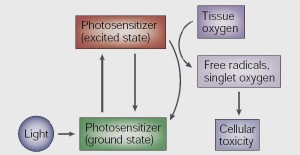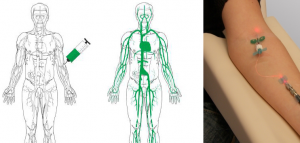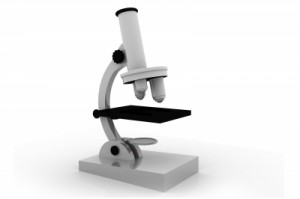Photodynamic Therapy
The key mechanism underlying our efforts is the Photodynamic Therapy (PDT).
Photodynamic Therapy (PDT) is one of the most interesting and promising treatment approaches in modern medicine: Up to now it is already used very successfully in oncology and dermatology.
The principle is the stimulation of a nontoxic light-sensitive substance (photosensitizer) by specific (laser-) light. The pathogen specific photosensitizers bind to any type of targeted malignant or other diseased cells in the organism with very high specificity. After stimulation with (laser) light, the targeted cells are destroyed by Type I or Type II photooxidative processes.
One of the major advantages of Photodynamic Therapy is that it can be applied without any side- effects.

Antimicrobial Photodynamic Therapy
Treatments that aim to kill pathogens of tropical diseases can be conducted analogous to treatments that are already used in tumor therapy.The treatment is then called Antimicrobial Photodynamic Therapy (aPDT).
For each disease, specific photosensitizers have to be identified. Afterwards, wavelengths and colour spectrums of the applicated light source need to be adjusted to the photosensitizer.
The identification of pathogen specific photosensitizers and optimal dosage ranges as well as of appropriate light sources is one of the major tasks that are pursued right now. In this context, pathogen specific photosensitizers for all major tropical diseases are known for years.
Click the image below to get an overview of key studies:
Advancement to in- vivo- applications
Until recently, the procedure could only be performed in vivo because it wasn’t possible to activate the substance within the body.
Only since a couple of years, the new technology of intravenous lasertherapy facilitates the activation of photosensitizers within the body. The way to practically treat Malaria and other tropical diseases is thereby paved.




